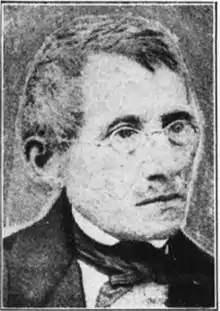Gideon Brecher
Gideon Brecher (Hebrew: גדעון ברכר; 12 January 1797 – 14 May 1873), also known by the pen name Gedaliah ben Eliezer (Hebrew: גדליה בן אליעזר, was an Austrian writer and physician. He was a central figure in the Moravian Haskalah.[1]
Gideon Brecher | |
|---|---|
 | |
| Born | 12 January 1797 Prossnitz, Moravia, Habsburg Empire |
| Died | 14 May 1873 (aged 76) Prossnitz, Moravia, Austria-Hungary |
| Alma mater | University of Erlangen |
| Spouse | Josephine Zadek[1] |
| Relatives | Moritz Steinschneider (nephew) |
Biography
Brecher was born in Prossnitz, Moravia, and attended yeshivot in Eibenschütz and Nikolsburg.[1] He was the first Jew of Prossnitz to study medicine or any other professional field. Brecher received a graduate degree in surgery and obstetrics at the University of Pest in 1824, and obtained a doctorate in medicine at the University of Erlangen in 1849, with the thesis Das Transcendentale, Magie und Magische Heilarten im Talmud (Vienna, 1850).
Brecher's fame in Jewish literature rests principally on this work and upon his lucid commentary on the Kuzari of Judah ha-Levi, which appeared with the text in four parts (Prague, 1838–1840). His correspondence with Samuel David Luzzato about this commentary was also published.[2]
In addition to many contributions to scientific and literary periodicals and collections, and some important "Gutachten" (expert opinions) on social and religious questions submitted to him by imperial and local government officials, Brecher is the author of a monograph on circumcision, Die Beschneidung der Israeliten (Vienna, 1845),[3] with an introduction by Hirsch Fassel, and an appendix on Circumcision Among the Semitic Nations, by Moritz Steinschneider. Brecher also wrote Die Unsterblichkeitslehre des Israelitischen Volkes (Vienna, 1857), of which a French translation appeared in the same year by Isidore Cahen; and Concordantiæ nominum propriorum, a concordance of Biblical proper names, part of which was revised and published after his death by his son Adolph Brecher.
Partial bibliography
- Das Transcendetale, Magie, und Magische Heilertarten im Talmud [Transcendental magic, and the supernatural methods of curing disease, as given in the Talmud] (in German). Vienna: Klopf und Eurich. 1850. hdl:2027/hvd.ah599p.
- L'immortalité de l'âme chez les Juifs (in French). Translated by Cahen, Isidore. Paris: A. Franck. 1857.
- Die Beschneidung der Israeliten von der historischen, praktisch-operativen und ritualen Seite [Israelite circumcision, described from historical, practical-operative, and ritual aspects] (in German). Vienna: F. E. von Schmid and J. J. Busch. 1845.
- Die Unsterblichkeitslehre des Israelitischen Volkes (in German). Leipzig: Oskar Leiner. 1857. hdl:2027/hvd.hnx7vf.
- Concordantiæ nominum propriorum quæ in libris sacris continentur, a divo patre (in Latin). Frankfurt: J. Kauffmann. 1876. hdl:2027/hvd.ah5lvg.
References
![]() This article incorporates text from a publication now in the public domain: Singer, Isidore; Wiernik, Peter (1902). "Brecher, Gideon (Gedaliah b. Eliezer)". In Singer, Isidore; et al. (eds.). The Jewish Encyclopedia. Vol. 3. New York: Funk & Wagnalls. p. 368.
This article incorporates text from a publication now in the public domain: Singer, Isidore; Wiernik, Peter (1902). "Brecher, Gideon (Gedaliah b. Eliezer)". In Singer, Isidore; et al. (eds.). The Jewish Encyclopedia. Vol. 3. New York: Funk & Wagnalls. p. 368.
- Miller, Michael L. (2012). "'Your Loving Uncle': Gideon Brecher, Moritz Steinschneider and the Moravian Haskalah". In Leicht, Reimund; Freudenthal, Gad (eds.). Studies on Steinschneider: Moritz Steinschneider and the Emergence of the Science of Judaism in Nineteenth-Century Germany. Studies in Jewish History and Culture. Vol. 33. pp. 37–80. doi:10.1163/9789004226456_003. ISBN 978-90-04-22645-6.
- Chamiel, Ephraim (2018). The Dual Truth: Studies on Nineteenth-Century Modern Religious Thought and Its Influence on Twentieth-Century Jewish Philosophy. Translated by Kallenbach, Avi. Academic Studies Press. ISBN 978-1-64469-102-1.
- Glick, Leonard B. (2005). Marked in Your Flesh: Circumcision from Ancient Judea to Modern America. Oxford: Oxford University Press. p. 127. ISBN 978-0-19-517674-2.